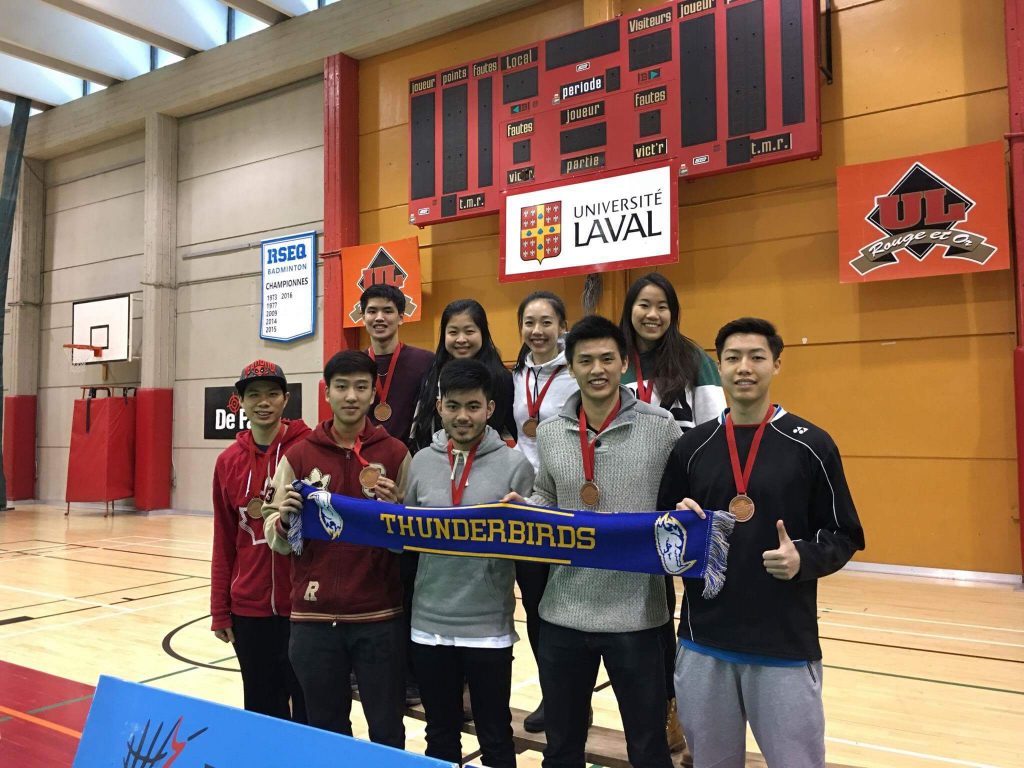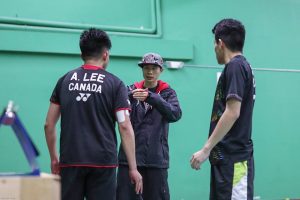
2016-2017 UBC Badminton Team at the 2017 College/University Nationals (Back L-R): James Ho, Jasmine Li, Isabelle Tang, Kylie Cheng (Front L-R): Toby Ng (Coach), Alex Lin, Aaron Lee, Allan Ng, Josh Liu

2016-2017 UBC Badminton Team at the 2017 College/University Nationals (Back L-R): James Ho, Jasmine Li, Isabelle Tang, Kylie Cheng (Front L-R): Toby Ng (Coach), Alex Lin, Aaron Lee, Allan Ng, Josh Liu
Interaction with others is a necessary thing, one way or another. We are all social creatures and I don’t think we would survive very long without the help of others. In a sport setting, it becomes extremely difficult if you need to do everything on your own. Although I have experienced doing a lot of things by myself as a player, I would never discount the assistance and efforts of those who have helped me along the way. I am who I am because of my interactions with others.
Perhaps it’s not the concept of whether we are interacting or not, but rather who we choose to do our interactions with. Perhaps there is also a level of comfort with certain people which causes us to stay where we are. Looking at my history as a player, I’ve been through many coaches. I would not expect anything else as a coach, for I have already coached many people. However, in badminton, there is a certain level of choice and our system has created personal coaches and National Team coaches (event only). Personal coaches would generally work with players in the same club, whereas National Team coaches would work with all eligible players who qualified for the event to represent Canada. Although the latter appears to be more important, both are required. It is analogous to considering whether training or competing is more important: both are necessary.
Given this level of choice, for a player to choose where they want to train is significant, as much as a coach choosing which athletes to take on personally. There is also a large transactional factor, where there are times coaches won’t say “no” if it gets food on the table. We are not always at the luxury to choose who we coach by specializing, but it can happen. Conversely, players choose coaches that may not always be the best fit. For example, former international players from strong badminton countries are often immediately seen as a good coach. But in my defense, as a Canadian athlete and coach, I have my own marketing strategies I will be using in the future. This is just business, and the interactions are often transactional: trading time and service for money.
However, despite the business of things, there are those who volunteer their time and service because they love the sport and want to see it grow. Maybe it gives them meaning and they enjoy doing what they do. I very much admire those people and I try to be one of them as well as best I can. Despite a busy schedule, I have volunteered to coach UBC’s badminton team for the season. Although they don’t have many events (only 4), there is an opportunity to play at the University Nationals in March 2017, which can qualify the winners to represent Canada at the World University Championships in Taiwan (August 2017). Although I may not be at all the events based on my own competition schedule, I do my best to lead practices and give players things to work on when they can.
Working with the UBC team has given me opportunities to demonstrate the core competency in a few ways. I ran two tryouts, with the first to filter out the best group of players (there were about 50 people who tried out), and with the second tryout, I was able to develop a core team (18 players). However, I really limited cutting the players and offered any people who made the second tryout a chance to continue practicing with the team. Despite a short season, there are other events that athletes might play, and I do my best to watch them play if possible. This is all on my own time, but it feels good to make that difference.

Of course there are reasons for me to keep a larger team, because I believe more players offer more depth, and also more people to train with. As a player, small team sizes make training extremely difficult, and training becomes less effective. To avoid this situation, I chose to have more people on the team. Additionally, expenses will be divided more evenly, and it becomes a lot more affordable to share the expenses for court time and equipment (e.g. shuttles). However, outside of practice, I know most people will gravitate back to their own social circles. This weekend, the team is competing at Vancouver Island University in Nanaimo. Unfortunately, I am currently in Edmonton (with one additional team member) competing at the Alberta Elite Series, which is a national circuit tournament. I trust the assistant coach and management team will manage the team appropriately. As much as I’m used to doing things on my own, I think this is a good lesson for me in letting go and delegating the job to a capable team. I trust they will do very well.
I also left the team a team-bonding exercise (maybe to satisfy my desire to do something even though I won’t be there). The exercise is simple: have a list of all the players and management staff on the team, and find a common interest with each person. There were a few rules, to prevent people from having a list of everyone saying “badminton” or worse, “living”. Another included that you cannot have the same item on your list more than once, so a player can’t go around asking people if they like “sushi” and have a cluster of “sushi” answers. Despite this ‘homework’ assignment, the purpose of the exercise is to create conversation between people that may not know each other off the court. I understand that there is that “fear of rejection” that lives in our minds when we meet new people, and sometimes that becomes a hindrance to initiating what could have been a great friendship. Additionally, since I know people would gravitate to their cliques, I want to minimize the chances that people would be left out. I understand that sometimes people may want some alone time, but I want to provide options for them if they don’t and are forced to be alone.
The second reason for this exercise is that it becomes more difficult to be in conflict with someone if you have a shared interest. Despite the many differences we have, it is often the similarities that hold us together. Also, if I have to be the person to resolve a conflict, I can use an analogy based on their share interest to resolve the conflict. For example, if two players don’t agree with a particular strategy, but love pizza, we would go eat pizza and I would tell them,
“Badminton tactics are like pizza flavours. If you keep on eating the same flavour, it gets boring. Sometimes you need to switch it up and try something else. However, the switch doesn’t need to be proportional, you just need to change. Then you will either decide that you actual like this flavour better, or you will realize that you still love your original flavour. This is the same as badminton strategies. Sometimes you need to use a different tactic to throw your opponent off, before returning to the former tactic, or keeping the new one if it is effective. There often is no “half-and-half” pizza, so you both need to agree on which pizza you want to start with, just as much as you can’t have both people using different tactics at the same time.”
Yes, I know it might be a bit cheesy (pun intended), but these kind of lessons and interactions are often the most memorable. In terms of the changes I have developed in this core competency, I would say that reading “The 7 Habits of Highly Effective People” by Stephen R. Covey was a very good read for me, especially his habit: “Seek First to Understand, then to be Understood”. I do suppose we often all have our own perceptions about the world and how it operates and we are seeing what we see through our own distortions, usually comprised of our beliefs, values, and former experiences. This concept has forced me to ask more questions to others as a way of trying to understand their perspective better. As much as I do want to try to “put myself in their shoes”, perhaps it’s not actually the best analogy, as it might mean simply asking, “What would I do in their situation?” and still be armed with my current resources and knowledge. If anything, I am still practicing how to “perceive as they perceive” and truly empathize with them, to better understand their situation. I may not have to agree with it, but I hope this practice can help me understand people better. I would definitely need more time to work on this and I will update in the next blog post for this core competency.
Additionally, another change I am trying to implement is to judge others less and accept more. We often find solutions for other people’s problems so much easier because we see it objectively and are free of their “emotional baggage” tied to the situation. Hence, seeking understanding when interacting with others would be an effective strategy. However, for my own purposes and problems, to look at the situation objectively, perhaps from an outside perspective while eliminating as much “emotional baggage” as possible may offer new insights to solving my own problems. Perhaps I will have an example for next time.